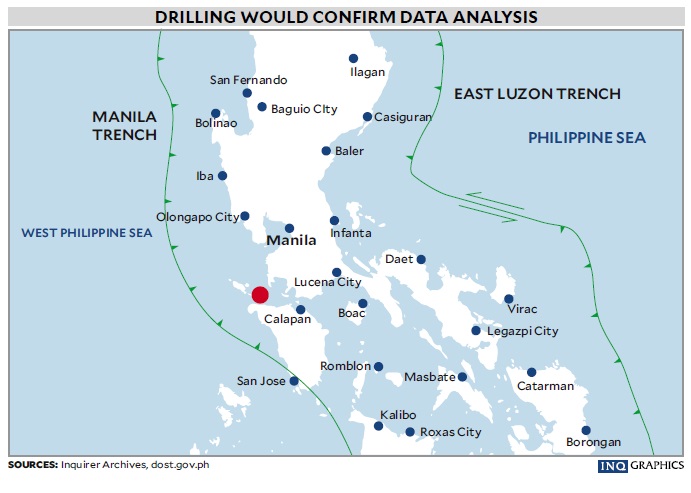
MANILA, Philippines — Geologists from the University of the Philippines said they had found possible evidence of gas hydrates — ice-like substances composed of water and methane that can be tapped as an energy source — in the Manila Trench, the long and narrow depression in the sea floor located west of Luzon and Mindoro islands.
“Much like carbonated drinks are water infused with carbon dioxide, gas hydrates are ice mostly infused with methane, a natural gas used as fuel,” UP Diliman College of Science (UPD-CS) said in a press statement about the results of a study on Wednesday.
The study, led by Elisha Jane Maglalang, Leo Armada, Madeleine Santos, Karla May Sayen, and Dr. Carla Dimalanta of the UP Diliman College of Science National Institute of Geological Sciences, was the first to investigate gas hydrates in Philippine trenches.
The researchers mapped out areas in the Manila Trench that exhibit bottom-simulating reflectors (BSRs), which indicate the potential presence of gas hydrates.
About the size of Palawan
Data analysis suggested that an area of about 15,400 square kilometers, or about the size of Palawan, could contain gas hydrates between 200 and 500 meters below the seafloor.
While gas hydrates are considered a potential source of energy, they also pose geological and environmental risks.
READ: China eyes Manila Trench as possible site for its underwater base
READ: Romualdez backs Marcos’ push for nuclear energy: We need cheaper, alternative sources
“Gas hydrates are great alternative energy sources, but they could also harm us and the environment,” UPD-CS said.
The Manila Trench is an active tectonic region prone to earthquakes, which could destabilize and cause the gas hydrates to dissociate, potentially triggering submarine landslides and tsunamis.
Greenhouse gas
The release of methane from melting gas hydrates could exacerbate global warming, as methane is a potent greenhouse gas.
“It is essential to determine the distribution and stability conditions of gas hydrates offshore of the Philippines,” the researchers added.
While BSRs are indicators of gas hydrates, the researchers noted that future drilling would be necessary to confirm the initial findings.
“These investigations offer a vital opportunity to develop our indigenous energy wealth,” they said.

